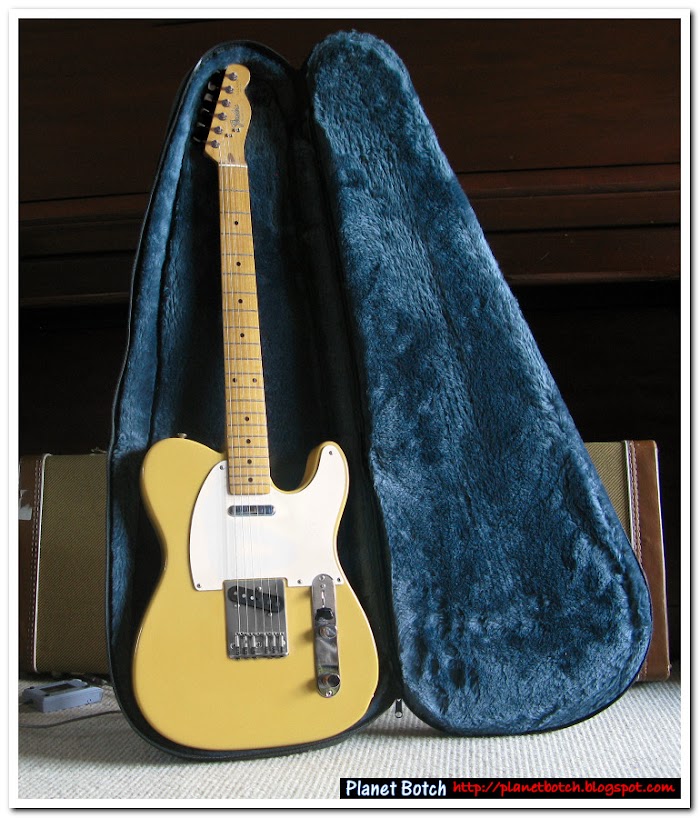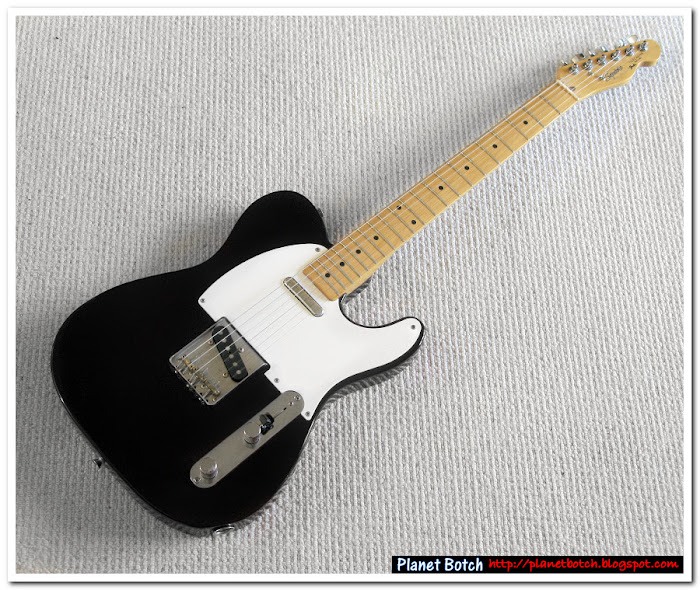After the demise of the hi-spec ‘JV Series’ and ‘SQ Series’ Squier Telecasters of the early to mid 1980s, Fender’s budget-end Tele dropped the homage to vintage instruments and headed into a new, more contemporary territory. Whilst this new-for-1985 Squier Japan Telecaster had features which would better connect with young players of the day (such as an easier to intonate bridge, and better-favoured pickup selection switching), it also cut costs in quite a pronounced way. Fender were now in a dream situation. They’d built a highly reputable brand with Squier since 1982 by selling top-class gear on the cheap. Now it was time to reap the rewards. Cut production costs in areas like the body wood, the pickups and the finishing, but use the brand’s rep to maintain the same prices in the shops.

The Fender Japan Standard Telecaster of 1988 to 1991 can be distinguished from the 1987 Korean Fender version by the truss rod access point, which is at the body end of the neck on the MIJ, and on the headstock of the MIK. The MIJ shows only a walnut 'teardrop' above the nut, whereas the MIK has a hole.
This new, cut-cost Squier ‘E Series’ Tele continued in production through 1986 and into 1987, but when Fender abandoned the concept of Squier Japan in ‘87, this particular model of guitar essentially survived.
Rebranded with a full Fender logo, this ‘E Series’ MIJ Tele initially went MIK, as production was moved to Korea, along with all of the new Squiers. Notably, whilst the Fender Korea and Squier Korea models looked almost identical, the Squiers had plywood bodies, whilst the Fenders retained the old Japanese solid wood spec.
But by 1988, while production of the new Squiers continued exclusively in Korea, manufacture of Fender’s old MIJ Standard Tele had swiftly returned to Japan. So now, if you wanted the '87 MIJ Squier Tele, you could once again get it, off the shelf, brand new. You would, however, need to ask for either a Fender Japan Special Series Tele, or a Fender Japan Standard Tele – depending on the date.
THE SPECIAL SERIES / STANDARD NAME
Okay, so brace yourself for some confusion… These former Squier MIJ ‘standard’ Teles in essence became Fender Standard Teles when the Korean operation began in ’87. However, had the rebranded MIJ Squiers been given the Fender ‘Standard’ name, there would have been three different Fender Standard Strats. One American Standard, one old MIJ Standard (discontinued but still in the shops), and one new Korean Standard, which was basically the rebranded MIJ Squier. To avoid problems for dealers who would have to differentiate between all these models in their listings, the rebranded MIJ Squiers (now being produced in Korea as full Fenders) were known as the ‘Special Series’, until stocks of the old Fender MIJ Standard Strats ran out. Even though there was no immediately pre-existing Fender Standard Telecaster, the temporary ‘Special Series’ name was carried over to the ‘E Series’ Fender Teles too.
Once stocks of the old Fender MIJ Standard Strats ran out and there could no longer be any confusion on the retail market, the ‘Special Series’ guitars were renamed as ‘Standards’. By that time, production of the ‘Special Series’ had moved out of Korea and back to Japan (told you it was confusing). So the progression was: Squier MIJ ‘Standard’ Tele > Fender Korea ‘Special Series’ Tele > Fender Japan ‘Special Series’ Tele > Fender Japan Standard Tele. It’s all essentially the same guitar, and the whole progression took place over a two-year period between 1987 and 1989. There's a full background to the major changes Fender implemented during that peiod in 1987: A Landmark Year for Fender Guitars.
After that, things were relatively clear until late 1991, when the new Mexican Fender Standard guitars arrived, again under the ‘Special Series’ name to ‘avoid confusion’, and dealers were forced to go through the whole semantic charade again.
So, with that about as clear as mud, in this piece I’m going to take a quick look at the former Squier MIJ ‘E Series’ Tele, which became the Fender Korea ‘Special Series’ Tele in ’87, then the Fender Japan ‘Special Series’ Tele in ’88, and finally ran as the Fender Japan Standard Tele between 1989 and 1991. From the end of 1991, it then morphed into the Squier Silver Series Tele up until the end of 1994, but let’s not make this any more confusing than it already is. Whoever would think that one guitar could have so many identities that it takes a writer about 370 words to properly introduce it? Mind you, this is Fender we’re talking about…
The features listed below are based on the 1989 model, but most apply to everything from the 'E Series' MIJ Squier, though the MIK Fender, to the MIJ Fender. The Silver Series differed in that it had a satin finish neck, colouring changes to the body and scratchplate, and mini-sized pots, but other than that it was still recognisable as the same guitar…
- A solid ‘hardwood’ body, with no string-holes. Standard colour options of black or blonde – always, of course, finished in poly. Distributors Arbiter would usually report these guitars as having alder bodies, but there was a perception that this was subject to variation.
- A ‘one piece’ maple neck with natural (untinted) gloss poly finish. No rosewood fingerboard variant available.
- An elongated bridge plate with six adjustable saddles, termination holes for the strings, and no raised sides. The saddles were not particularly stable and could move from side to side – especially given the fairly weak string tension caused by the low break angle.
- Alnico pickups (more on these later in the piece).
- A ‘top-hat’ style black switch cap and tall, knurled, ’60s/’70s-derivative, non-domed metal knobs.
- A single-ply white scratchplate with just five fixing screws.
- Gotoh tuners with user-adjustable tension.
- A silver-coloured ‘Transition’-style (not Spaghetti) Fender or Squier logo - depending on the year. This is one of the most straightforward ways to recognise these guitars when their hardware has been doctored. They also had their serial numbers on the headstock, along with the ‘Made in Japan’, or ‘Made in Korea’ designation. Remember, if it’s Made in Korea, it MUST be a Fender and not a Squier in order to qualify as this model. A Korean Squier would have a plywood body and be a significantly cheaper instrument. You might expect the Korean Fenders to be worth less than the MIJs, but there are far fewer MIKs than MIJs, and the MIKs look to have been well made by Young Chang, so it may pan out pretty evenly.
- A MSRP (RRP) of £252 in spring 1989, rising to £295 in summer 1991, shortly before the redevelopment into Squier Silver Series format, introduced at £275.

Immediately after the demise of the JV and SQ Series Squier Telecasters came 1985's Squier (MIJ) E Series Teles. In all original condition there would be virtually no difference between one of these and a Fender Japan Standard Telecaster of 1991. On the mid '80s E Series Squier in the picture, the original six-piece bridge has been replaced with a 'top-loading' brass saddle three-piece, and a vintage type MIJ lead pickup has been substituted for the stock Squier, but other than that the appointments are as standard.
IN USE
So, by the end of the 1980s, this Telecaster was the most basic and inexpensive in the Fender-branded range. How did it compare with more expensive options?
Well, the biggest drawback for me was the bridge arrangement, and the fact that the strings were anchored behind the saddles rather than through the body. There was an obvious difference acoustically between these Standard Teles and the Fender Vintage Reissues, which had a tradtional Telecaster bridge and the through-body stringing method. And it wasn’t just that the string tension and the body resonance were compromised on the Standard Tele – the saddles themselves were flimsy and very slightly ‘Xmas cracker’ in nature. The whole setup made for a rather uninspiring personality, which was described in a professional review as “numb”. The body wood wasn’t spectacular either. When a manufacturer changes a blonde finish from translucent (JV and SQ Squiers) to opaque (E Series), it’s usually a pretty sure sign that they’ve downgraded the body spec, and that, I’m sure, was another contributor to the guitar’s rather ‘wallflower’ attitude.
I actually switched this six-saddle bridge for an ESP replacement with classic ‘50s heavy brass saddles, and even though the strings still didn’t pass through the body, there was a clearly evident increase in resonance and sustain. Stringing through the body would help further still of course, but that’s an irreversible customisation most owners would probably be reluctant to take on. It’s not easy to make a good job of something like that, and once it's done, it's done.
The pickups on this Tele were alnicos (unlike the Standard MIJ Strats, the Teles resisted the late ‘80s switch to ceramic units). However, the pickups were still budget products, not in keeping with the vintage design. The bridge unit lacked the copper bottom plate, the wax-potting and the waxed black string wrap around the coil. The tone was pretty well balanced, but again, there was a lack of personality, further exacerbated by that bridge construction. Replacing the entire bridge, including the pickup (perhaps putting in something like a Seymour Duncan Vintage Broadcaster), does transform the sound of these guitars into something much more identifiably Tele. But given that in 1989 a Fender MIJ Vintage Reissue would only be about £50 more expensive in the shops, and the reissues produced an archetypal Tele sound straight off the rack, the ‘Standard’ Tele could prove a false economy.
CONCLUSION
The multi-ID Squier/Fender Standard/Special Tele of the late ‘80s and early ‘90s was really a budget guitar, however it was branded. The necks, in my experience, were very nice, but there was never any danger that someone would confuse one of these with a range-topper. Absolutely nothing at all wrong with this Tele, but as someone who loves the vintage Telecaster sound, it never set my world alight. I like a Tele to leap out of a mix and identify itself. For me, these didn't. You can customise them, obviously. But there’s an old joke from the nearby Black Country (so called because of its industrial past with dark, polluted skies and soot-caked buildings), in which a stranger asks a local how to get to Birmingham. “Well,” replies the local, “if I was gonna go to Birmingham, I wouldn’t start from here.”
More Squier Guitar Articles
More Telecaster Articles

